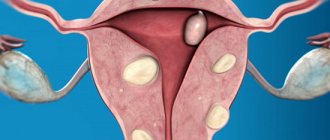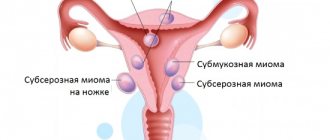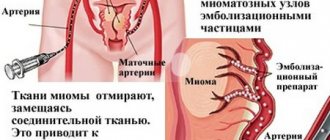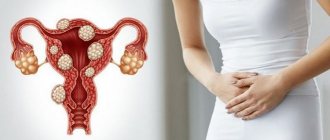How uterine fibroids affect menstruation
When benign tumors appear in the uterus, the nature and regularity of menstruation may change. In some people, in the initial stages, fibroids do not cause any symptoms and are discovered by chance during a routine examination. But in most women, when fibroids appear, menstruation becomes irregular, painful and heavy.
Most often, patients encounter the following disorders:
- increase in the duration and abundance of menstruation;
- the appearance of intermenstrual bleeding;
- decrease in the duration of the menstrual cycle (menstruation begins to occur more often than once every 21 days);
- the appearance of frequent, irregular periods;
- increased pain during menstruation.
Women of reproductive age suffer from changes in the regularity and abundance of menstruation. After the onset of menopause and the cessation of menstrual function, fibroids decrease in size and may even disappear.
Types of neoplasms
The neoplasm can be multiple or single. In the first case, it is quite difficult to distinguish the boundaries of existing nodes; in the second, the neoplasm has clear boundaries. There are the following types of nodes, they have different effects on the nature of a girl’s menstruation:
- subserous - forms in the muscular layer of the uterus and rarely causes a change in the nature and duration of the cycle;
- submucosal – formed in the submucous membrane, it is characterized by active bleeding, ending in the development of anemia, and often causes infertility;
- intramural - located in the middle muscle layer, the development of the tumor leads to an enlargement of the uterus, compression of nearby tissues, cycle disturbances appear, menstruation can take a long time, but is not cyclical.
Menstruation with fibroids
Based on the changed nature of menstruation, one can suspect the development of a benign tumor. In most patients, the profuseness of discharge increases and intermenstrual bleeding appears. But it is possible that menstruation may be delayed due to uterine fibroids. Some patients complain of spotting after menstruation and increased pain.
The color of menstrual discharge in patients with fibroids varies from bright red to dark brown. This is due to the inclusion of a large amount of blood. Large clots – endometrial particles – may appear.
Attention! If the discharge is profuse, the pads need to be changed every 1-1.5 hours, then you should contact a gynecologist.
If your general health worsens or your blood pressure drops, you should immediately call an ambulance.
Can fibroids cause missed periods?
The appearance of delays in benign uterine tumors is rare; bleeding is a more characteristic sign of their development. But the duration of delays in patients with myomatous nodes can reach several months.
If there are no critical days for a long time, pregnancy must be excluded. If conception does not occur, then you should check your hormonal levels.
The most common cause of delayed menstruation due to uterine fibroids is ovarian dysfunction. This condition is characterized by alternating delays with heavy bleeding.
How many days does menstruation last with fibroids?
The duration of menstruation depends on its intensity. A scanty period can end in 3 days, while a heavy period lasts 7 days.
If the intensity of the discharge does not decrease, and it continues for more than a week in a row, then you should consult a doctor. The doctor may prescribe hemostatic therapy or leave you for observation in the hospital.
Why do you have heavy periods with fibroids?
The appearance of heavy periods with fibroids is due to the growth of nodes in the submucosal layer. They interfere with the contraction of the uterine cavity. As a result, bleeding becomes profuse and prolonged.
An increase in the intensity of discharge may be due to the fact that large fibroids put pressure on surrounding tissues, causing ruptures of blood vessels. This may cause bleeding.
Scanty periods with uterine fibroids
A decrease in the intensity of menstrual flow occurs in few women with fibroids. Scanty periods indicate hormonal imbalance. This is a rather dangerous situation, because with an imbalance of hormones, tumor growth can increase.
Large myomatous nodes can interfere with endometrial detachment and the release of menstrual blood. The bulk of the discharge accumulates inside the uterine cavity. This condition is dangerous; the woman needs urgent surgery.
If hormonal imbalance is confirmed in patients with scanty uterine menstruation, special means are prescribed, under the influence of which it is possible to normalize hormonal levels. If, despite the treatment, the fibroid grows rapidly, then surgery is recommended.
Why do you not have periods with fibroids?
Long-term absence of menstruation in patients with fibroids can be caused by:
- changes in the structure of the myometrium;
- pregnancy;
- deterioration of blood microcirculation in the endometrium.
Attention! When pregnancy occurs against the background of fibroids, caution must be exercised. After all, a tumor can cause miscarriage or premature birth.
Features of cycle change
Myoma can remain dormant for a long time. Its growth can be triggered by various factors, for example:
- noticeable fluctuations in hormonal levels;
- inflammatory processes occurring in the uterine cavity;
- trauma to the mucous membranes as a result of abortion or childbirth;
- hereditary predisposition;
- late pregnancy;
- long-term use of COC drugs;
- serious stress;
- use of alcohol or drugs;
- smoking;
- obesity.
A small tumor rarely makes itself felt symptomatically; the first sign is an increase in the volume of menstrual flow. Radical treatment methods are used only when the tumor affects and disrupts reproductive function. Sometimes drug treatment is acceptable, but it rarely achieves the desired result.
Since the neoplasm is hormonal-dependent, bleeding does not always become profuse; in some cases it becomes scanty. A distinctive feature is the irregularity of the cycle and a noticeable increase in its days.
Cycle duration and violations
Delay, as well as heavy menstruation, should not be considered by women as a diagnostic criterion for identifying uterine fibroids. This symptom most often appears when the tumor reaches a large size. Disorders appear due to the rapid growth of connective tissue of the reproductive organ and its hypertrophy.
Against the background of the pathology, menstruation becomes abundant and often irregular, often accompanied by pain. Menstruation occurs 2 times per cycle, it shortens, and the pain becomes more pronounced. The reason for the changes is the rapid growth of the endometrium due to hormonal imbalance.
Delays are observed much less frequently. They are associated with insufficient production of hormones by the ovaries. After a long absence, menstruation begins, accompanied by intense pain, and the amount of blood loss is critical. Scanty menstruation lasts 3-4 days, long periods last about 2 weeks.
Heavy periods with uterine fibroids
The reason for the change in the volume of blood loss is due to the fact that the tumor before the onset increases in size along with the reproductive organ. The neoplasm puts additional pressure on the tissue and provokes rapid stretching of the mucous membranes. The myomatous node has its own circulatory system; when stretched, the vessels burst and due to this the volume of blood loss increases.
Menstruation with fibroids becomes abundant due to characteristic changes in endometrial tissue. Without changing their intensity, they last up to 7 days. The consistency can be different; in the first days, abundant clots with massive pieces often come out of the uterine cavity, then it changes to watery and more homogeneous. The color varies from brownish-brown to scarlet.
Attention! Liquid scarlet blood should alert a woman. Most likely this is uterine bleeding.
In all cases, if such atypical changes are detected, you should seek emergency medical help. Lack of timely intervention is dangerous for the development of anemia and severe weakness. The problem can be eliminated after diagnosis and identification of the provoking causes.
Brown spotting discharge
Brown discharge for a few days after menstruation is normal for any woman; cases with fibroids are not exceptional. If the discharge lasts longer and resembles menstrual discharge in intensity, it is worth talking about the pathological growth of the endometrium and the course of the inflammatory process in the uterine cavity.
The appearance of discharge between periods indicates an excess of estrogen in the body. Under the influence of the sex hormone, uneven thickening of the uterine mucosa occurs, and menstruation does not ensure complete rejection of the cells.
Pain accompanying menstruation
The intensity of the pain syndrome increases noticeably as the tumor grows. The pain becomes most pronounced in the interstitial position due to the fact that the intermuscular space is compressed. The growth of the tumor is directed towards the uterine cavity. The sensations are often dull, less often cutting and cramping in nature.
With a significant increase in the size of the pseudotumor, compression of the nearest organs can be observed, and pain occurs due to the pressure exerted on neighboring organs. A woman experiences dyspeptic disorders and the frequency of urination increases.
Discharge from fibroids after menstruation
Myomatous nodes affect not only the intensity, regularity and nature of menstruation, they provoke the occurrence of intermenstrual bleeding. Depending on the type and location of the nodes, menstruation changes. But even with the same nodes, discharge from different women during and after menstruation can differ significantly.
Spotting with fibroids in the middle of the cycle
Intermenstrual spotting is common in patients with uterine fibroids. Spotting may appear during ovulation or immediately after the end of menstruation. Most often, the separated contents are brown or beige.
What is uterine fibroid
The uterus is a muscular organ consisting of three layers, the thickest of which is the myometrium. It is the muscular layer of the uterus. Myoma in its structure is a benign hormone-dependent tumor, which is presented in the form of nodes in the muscular layer of the uterus. Women aged 35-50 years are at risk of development, but now gynecologists note a trend towards rejuvenation of a dangerous age. Patients aged 25 years and younger may encounter the pathology if there has been a history of childbirth.
Depending on the size of the tumor, the following classification is acceptable, establishing the dimensions of the tumor according to the gestational age:
- small – 5-6 weeks;
- average – 7-11 weeks;
- large – 12 or more weeks.
Based on the histological structure, they are distinguished:
- uterine fibroids - consists of muscle elements;
- uterine fibroid – includes connective tissue;
- Uterine fibroids - consists of muscle and connective tissue.
Attention! Uterine fibroids are a benign neoplasm, the main reason for the formation of which is an imbalance of hormones. The hormone estrogen predominates in the girl’s blood, and due to such fluctuations, cycle disorders occur.
Menstruation after removal of uterine fibroids
The operation to remove fibroids is called myomectomy. It is prescribed if conservative therapy is ineffective or the fibroids are growing rapidly.
Menstruation does not disappear after myomectomy, because reproductive function is preserved. A long delay after surgery is allowed, but within 2-3 months, in the absence of concomitant pathologies, the regularity of menstruation is normalized.
The recovery process after myomectomy depends on the method of the operation, its complexity, the location of the fibroid and its size. The intensity and nature of the discharge returns to normal by the beginning of the next menstrual cycle. You can speed up the recovery process if after surgery:
- exclude intense physical activity for six months;
- observe sexual rest for 2-3 months;
- stop drinking alcohol and smoking.
If after the operation heavy periods begin again, accompanied by severe pain, then it is necessary to exclude a recurrence of the disease.
How long does it take to start menstruation after fibroid removal?
Menstruation should begin on time after removal of uterine fibroids using the laparoscopic method. But it is possible to lengthen the cycle to 35-45 days. Delay after myomectomy occurs due to trauma to the walls of the uterus.
If surgeons remove the uterus, menstruation will not be restored. If the reproductive organs are preserved, the cycle should normalize quickly. In cases where the delay after surgery exceeds 1.5 months, a consultation with a gynecologist is necessary. You can check how recovery is going with an ultrasound.
Heavy periods after myomectomy
After the operation, the nature of the discharge should change. Your periods should be the same as they were before the tumor appeared.
If bleeding occurs after a myomectomy, you should undergo an examination. Among the most likely causes of this condition are:
- the appearance of new myomatous nodes in the uterus;
- injury to neighboring organs as a result of surgery;
- weakening of the muscles of the uterus, deterioration in the process of its contraction.
Deterioration of the muscle tone of the uterine walls occurs in women who have had large tumors removed.
Important! Immediate consultation with a doctor is necessary if a woman has heavy periods accompanied by severe pain, nausea, fever, and urination with blood.
Influence
Uterine fibroids most often affect the menstrual cycle. Depending on the type, size and location, it can cause both scanty and abundant discharge. Sometimes there is a delay in menstruation. Also, in some cases, bleeding that is not associated with the cycle is characteristic.
Location of nodes
Small fibroids, a few centimeters in diameter, often do not affect the menstrual cycle. And in general, her presence is asymptomatic for a long time. Sometimes even medium-sized tumors do not manifest themselves at all. However, large nodes almost always change the menstrual cycle. This is most typical for submucous formations.
Heavy discharge
In some cases, heavy periods are observed with fibroids. This situation develops because increased cell division is observed in the uterus, due to which fibroids grow. But this division also affects the endometrium. As a result, it thickens unevenly over its entire area. It also cannot be rejected evenly.
Why is there heavy discharge with fibroids? If the thickening of the endometrium is significant, then rejection is more active. Outwardly, this manifests itself as heavier periods with fibroids.
With fibroids, the endometrium thickens
This condition is quite dangerous. As a result, the body loses blood. Oxygen starvation (hypoxia) of the pelvic organs occurs. In some cases, with prolonged menstruation, persistent anemia develops. In other cases, hemorrhagic shock may even occur.
Scanty discharge
Scanty periods with uterine fibroids are much less common. This is also a sign of hormonal imbalance, which indicates that the endometrium is not being rejected intensively enough. This deviation can lead to accelerated growth of fibroids.
Another reason for scanty periods in this case is a very large fibroid. It can obstruct the flow of menstrual blood from the uterus. As a result, a cavity is formed in the organ, which is filled with blood. It can only be removed surgically.
Uterine bleeding
Can fibroids cause bleeding outside the menstrual cycle? This is a characteristic phenomenon associated with endometrial renewal. Active production of the hormone estrogen (which provokes the growth of the cyst) leads to the fact that the endometrium thickens unevenly. In places of excessive thickening, it can be rejected even not in connection with menstruation. In addition, with this condition, not the entire endometrium is renewed during menstruation. And some cells are rejected after menstruation.
There are other reasons for such phenomena. They are associated with the contractility of the organ. The presence of a neoplasm puts significant stress on the muscular layer of the uterus. As a result, this negatively affects the arteries. For this reason, they do not contract in a timely manner and bleeding occurs.
Uterine bleeding with fibroids is usually spotting in nature. They are not too abundant (in untreated cases). However, if they are constantly present, they can cause the development of anemia. The result is weakness, drowsiness, and pale skin.
Menstrual pain
Increased menstrual pain is a characteristic feature of fibroids. Pain in the lower abdomen may be present without connection with menstruation. But during menstruation they always intensify. There are the following reasons for this:
- Myoma is combined with adenomyosis or endometriosis;
- Localization of fibroids in the interligamentous or submucosal space;
- Large fibroids compress nearby organs - the intestines, the bladder.
Strictly speaking, pain occurs because the uterus tries to push the tumor out of its cavity, contracting intensely. In terms of mechanism, this vaguely resembles contractions during childbirth.
This course of symptoms is most typical for small nodules. If they are located in the interligamentous space, the pain can be intense. Moreover, they reach maximum intensity in the first days of the cycle. Then their intensity decreases, but they do not disappear completely. They may appear periodically even outside of menstruation.
Cycle disorders
Since the menstrual cycle is regulated by hormones, it can change with fibroids. After all, the occurrence of fibroids also occurs exclusively due to hormonal imbalance. There is a significant shift in the time frame of the cycle. Typically, menstruation occurs more frequently. Although the cycle becomes much shorter, it is often still within the normal range.
This change is accompanied by increased menstrual pain and heavier bleeding. However, they can last much longer than usual - up to 7-10 days.
In rare cases, menstruation may be delayed. This also happens in the early stages of the disease. A delay in menstruation with uterine fibroids occurs when the neoplasm arises as a result of ovarian dysfunction. Also, with fibroids there may be a delay for the following reasons:
- Disturbances in the structure of the myometrium and endometrium;
- Impaired blood circulation;
- Impaired blood flow.
Do not forget that although the likelihood of pregnancy with fibroids is low, it still exists. For this reason, it is important to consider that a delay in menstruation with uterine fibroids could also occur due to pregnancy. Therefore, in case of a long delay, in any case, it is recommended to do a test.
Consistency of discharge
With tumors in the organ, other types of disturbances are possible during menstruation. The consistency of the discharge often changes. This is due to the fact that with characteristic changes in the myometrium, the amount of blood directly in the secretions increases. Because of this, they become more dense and clots can form.
The color of the discharge also changes. They become bright scarlet or dark. This also happens due to the large amount of blood in them. Quite large fragments of the endometrium may be present in the discharge; as a result, it leaves the body in the form of fairly large clots.
However, sometimes the density of the discharge decreases significantly. They are liquid, almost like water. This is a sign of uterine bleeding. If it is intense, it is recommended to consult a specialist. It is usually not possible to cope with this phenomenon on your own.
Can fibroids come out?
As mentioned above, pain during menstruation can be associated with intense spasms of the smooth muscles of the uterus (myometrium). A process similar to labor (contractions) occurs. During this process, the uterus tries to push out the neoplasm, i.e., fibroids.
In some cases she succeeds. For example, when the fibroid is small or, conversely, very large. Or has a narrow base. This is a rather unfavorable course of the disease. The process is accompanied by very strong pain. After this, very intense bleeding develops. In this case, only a doctor can often stop the bleeding.
Can fibroids come out with menstruation?
Occasionally, there are cases when myomatous nodes come out during menstrual periods. The pathology is called a nascent node. This is a pedunculated tumor growing towards the os of the uterus. Contraction of the myometrium around the tumor stalk leads to its thinning. The fibroid becomes mobile and may fall out into the vagina.
If a myomatous node prolapses, immediate surgical assistance is required. Using special forceps, the surgeon must grab the knot, twist it and pull it through the vagina. At the end of the procedure, the vessels that were damaged are coagulated, and the uterine cavity is scraped out.
The following signs indicate the release of fibroids:
- discharge of a large amount of blood from the vagina;
- sharp cramping pain;
- drop in blood pressure;
- feeling of a foreign body appearing in the vagina.
The cause of the birth of a node can be excessive physical activity, stress, chronic inflammatory diseases of the genitourinary organs.
How does the cycle change with fibroids?
Myomatous nodes in the uterine cavity, having a size of more than 12 weeks, adversely affect the performance of some vital organs:
- Gastrointestinal tract;
- Bladder;
- Reproductive organs.
As a result of the negative impact on the reproductive system, first of all, the presence of fibroids minimizes a woman’s likelihood of becoming pregnant. Also, the progression of a benign formation provokes a disruption of the menstrual cycle; with fibroids, there may be a delay in menstruation - the most common problem, and the following disorders also occur:
- Excessively long-term (more than 7 days) or short-term regulation (less than 4 days);
- Heavy discharge with large blood clots;
- Periodic uterine hemorrhages;
- Intense pain in the lower abdomen during menstruation;
- Regular appearance of slight bleeding during the intermenstrual period;
- Too scanty or heavy periods with fibroids.
Statistics show that in advanced stages of the disease, most often the profuseness of bleeding increases, the menstrual cycle shortens, and the periods are prolonged. As a result, a woman may develop anemia (anemia).
At the initial stage of fibroid development, there is often a delay.
What to do if you have heavy periods with fibroids
If heavy menstruation appears, which is difficult to distinguish from bleeding, an urgent consultation with a gynecologist is necessary. After assessing the condition, the doctor may recommend conservative treatment or admit the patient to the hospital.
Therapy is aimed at stopping bleeding with the help of drugs that increase the contractile activity of the uterus. At the same time, hemostatic drugs are prescribed - Vikasol, Tranexam, Dicynon.
Hormone therapy is actively used for medicinal purposes. Prescribed drugs that prevent the production of gonadotropins, help reduce the size of the uterus and stop menstruation for the period of treatment. Decapetil, Nofarelin, Zoladex are often prescribed.
The condition can be normalized by reducing the production of estrogen and increasing the level of prostaglandins. This effect can be achieved using the Duphaston or Norkolut regimen. Sometimes, under their influence, fibroids resolve.
If it is not possible to reduce the intensity of the discharge and stop the growth of fibroids using conservative methods, then surgery to remove the tumor is prescribed.
Uterine bleeding due to uterine fibroids
In some cases, menstruation becomes so heavy and long-lasting that it develops into acyclic bleeding. This manifestation is characterized by the location of fibroids in the submucosal layer or intermuscular space of the uterus.
Bleeding may also occur in the middle of the cycle for two reasons:
- The remains of the endometrium come out, which due to the unevenness of the layer, did not all come out during menstruation.
- Lost control over the ability of the uterus to contract. The arteries are not pinched, causing bleeding.
In addition to these reasons, the opening of bleeding is provoked by:
- increased volume of the uterus;
- thickening of the uterine mucosa;
- changes in the vascular network and venous plexuses.
If the amount of secreted sanguineous fluid exceeds 80 ml per day, then we will be talking about uterine bleeding. The woman urgently needs hospitalization, where she will be prescribed appropriate treatment.
In the gynecology department, a patient with uterine bleeding is prescribed hemostatic drugs and drugs that reduce the volume of discharge (as with heavy periods).
Surgical curettage is performed if indicated.
Traditional medicine involves the use of the same herbs as in the treatment of heavy menstruation.
Nettle decoction increases blood clotting
How does it affect the menstrual cycle?
Fibroids do not always lead to changes in the nature and duration of menstruation. It all depends on:
- sizes,
- number of nodes,
- their locations.
The larger the size of the fibroids, the more it will deform the body of the uterus and the endometrial cavity. This will generally lead to abnormal contraction of muscle fibers during menstruation, bleeding, and intermenstrual discharge. Nodules up to 3 cm are most often a “find” during a pelvic ultrasound and do not show any symptoms.
The more nodes, the higher the likelihood that the muscles of the uterus will not respond correctly to its contractions during menstruation. However, small nodules (up to 2 cm), even with a large number of them (more than 5-7), located in the thickness of the muscle layer, may also not give any clinical symptoms for years.
The location of the nodes has the greatest influence on the menstrual cycle:
- Subserous . They have the least effect on the amount and nature of discharge, but can cause pain and discomfort not only during menstruation, but also on other days of the cycle.
- Submucosal . They have the most vivid clinical picture. Protruding into the uterine cavity, they increase the area of the endometrium, which provokes heavy bleeding and spotting outside of menstruation.
- Interstitial . Depending on their size, they may not show themselves at all, or may cause bleeding (if they tend to grow into the uterine cavity).
Heavy discharge and bleeding
Characteristic of nodes that grow inside the uterine cavity are submucosal. Even small sizes of such fibroids (even up to 1 cm) can cause heavy bleeding, which can only be stopped by curettage of the uterine cavity.
This is explained by the fact that in the growth zone of the submucosal node there are abnormally located vessels, which make it more difficult for them to reduce their lumen during menstruation, and this leads to copious discharge with clots. Plus the surface of the node is an additional rejection zone.
Heavy discharge during menstruation and even bleeding can cause:
- multiple nodes of any location;
- large subserous and interstitial nodes.
The uterus can be “stuffed” with nodes, which changes its contractility and vascular anatomy. If at a young age the body can still cope with these manifestations of the disease, then over time bleeding will bother the woman more often.
The main sign of heavy menstruation, which the body cannot cope with, is a decrease in the level of hemoglobin in the blood. Sometimes women seek medical help already at levels of 60-70 g/l, when indications for transfusion of blood components may arise. The more abundant the discharge, the lower the hemoglobin level. At the same time, the woman begins to worry:
- headaches and dizziness, which intensify during menstrual periods;
- weakness, increased fatigue;
- shortness of breath even with normal physical activity and even walking.
Expert opinion
Daria Shirochina (obstetrician-gynecologist)
Anemia due to fibroids is a direct indication for removal of nodes, sometimes along with the uterus and appendages.
Scarce
Scanty periods with fibroids are rare. If only it is small in size and does not affect menstruation in any way.
Nodes located in the area of the uterine isthmus can interfere with the outflow of menstrual blood. In this case, the woman will notice scanty discharge, pain in the lower abdomen, and prolonged spotting before and after.
Cycle failures
Also characteristic of fibroids, because it is a consequence of existing hormonal disorders in a woman’s body. Failures are more often characterized by delays. An incomprehensible spotting may also occur on any day of the cycle, and the woman may be confused as to when is the first day of her period and what is considered a violation.
Cycle disruptions can be evidence not only of existing fibroids, but also of a combination of pathologies - the presence of polyps in the uterine cavity, endometrial hyperplasia.
Nature of the discharge
Menstruation with fibroids may not differ in color from the usual ones that the woman had before. But the following may appear:
- clots - when there is heavy discharge or when it is difficult to remove it from the uterine cavity;
- daub - as a consequence of the presence of polyps in the uterine cavity, hyperplasia, with narrowing of the cervical canal with a cervical location of the node;
- very abundant “like a bucket” - indicate the need for medical attention and the issue of removing the nodes, since they will soon lead to moderate or severe anemia.
Watch this video about the causes and symptoms of uterine fibroids:
Pain
They are a frequent companion of fibroids. This is due to the following:
- the nodes disrupt the normal contractility of the uterus - an excessive amount of prostaglandins is released, which causes pain and cramps during menstruation;
- fibroids compress the nerve endings - this causes a feeling of heaviness in the lower abdomen, aching pain in the lower back, perineum, this is often typical for fibroids more than 6 cm in diameter;
- nodes compress neighboring organs - even small nodules (about 3 cm in diameter), but located subserosally and close to the rectum or bladder, put pressure on these organs and can impair their functions, for example, women may complain of frequent urination and a feeling of incomplete emptying , constipation;
- “birth” of a myomatous node - if the fibroid is located submucosally and on a pedicle, it can descend on its own and then protrude into the cervical canal, like a baby’s head; in this case, the woman will feel cramping pain in the lower abdomen until the node “is not born” or is surgically removed.
Hemostatic agents for fibroids - traditional and folk medicine
When the discharge from fibroids turns into bleeding, the woman may be hospitalized, since treatment in such a situation will be purely individual, and it must be selected in a hospital. If the situation is not critical, the doctor will prescribe a hemostatic drug based on the clinical picture of the disease and examination results. The most effective today for menstrual bleeding are:
- "Dicynon";
- "Tranexam";
- "Vikasol";
- "Etamzilat";
- "Oxytocin";
- "Ascorutin" and others.
Medicines can be given orally or by intramuscular injection.
To regulate menstruation with fibroids and stop uterine bleeding, you can use folk tips and recipes. However, before making a tincture or decoction, you must consult with your gynecologist.
With the consent of the doctor, a decoction of the herb uterus can be used to stop uterine bleeding. Nettle, water pepper, and yarrow also have an effective effect on fibroids.










